University Portfolio Management Implementation Report - PROJ6005
VerifiedAdded on 2022/09/27
|12
|3138
|21
Report
AI Summary
This report provides an in-depth analysis of the project portfolio management (PPM) implementation within the Woolworths Group. It begins with an executive summary and an introduction setting the context for the evaluation. The report covers the situational context, including investment strategies and organizational capacity. It delves into portfolio evaluation, detailing the use of the AHP (Analytic Hierarchy Process) method and the benefits management lifecycle. The report explores portfolio management, focusing on the Project Management Office (PMO) and its impact, along with tools and techniques used for project management. It assesses the maturity levels of PPM, highlighting the organization's progress and the P3M3 model. The report also examines the corporate culture and resistance to change. The conclusion summarizes the findings and provides recommendations for improvement, offering a comprehensive overview of PPM implementation challenges and successes within Woolworths.
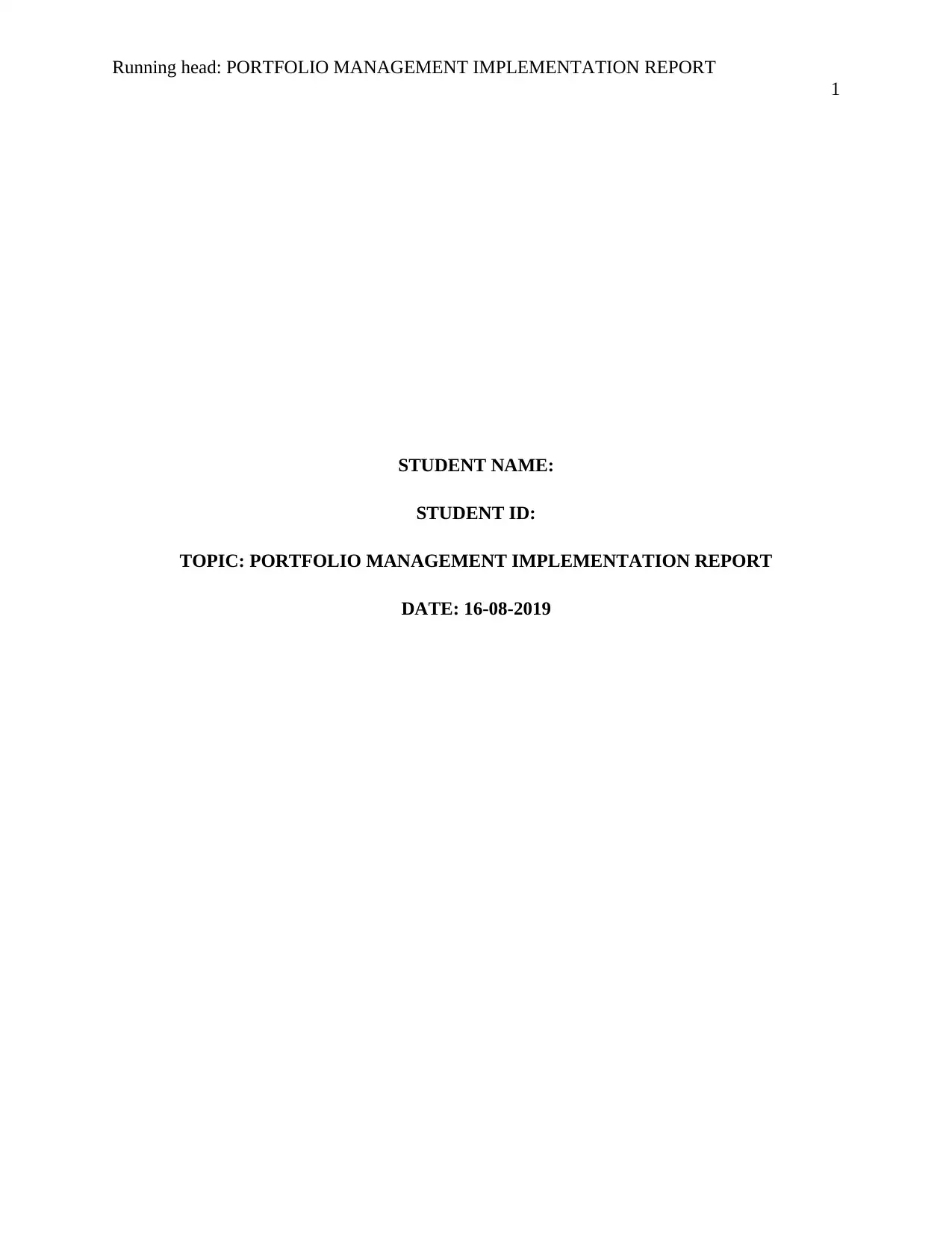
Running head: PORTFOLIO MANAGEMENT IMPLEMENTATION REPORT
1
STUDENT NAME:
STUDENT ID:
TOPIC: PORTFOLIO MANAGEMENT IMPLEMENTATION REPORT
DATE: 16-08-2019
1
STUDENT NAME:
STUDENT ID:
TOPIC: PORTFOLIO MANAGEMENT IMPLEMENTATION REPORT
DATE: 16-08-2019
Paraphrase This Document
Need a fresh take? Get an instant paraphrase of this document with our AI Paraphraser
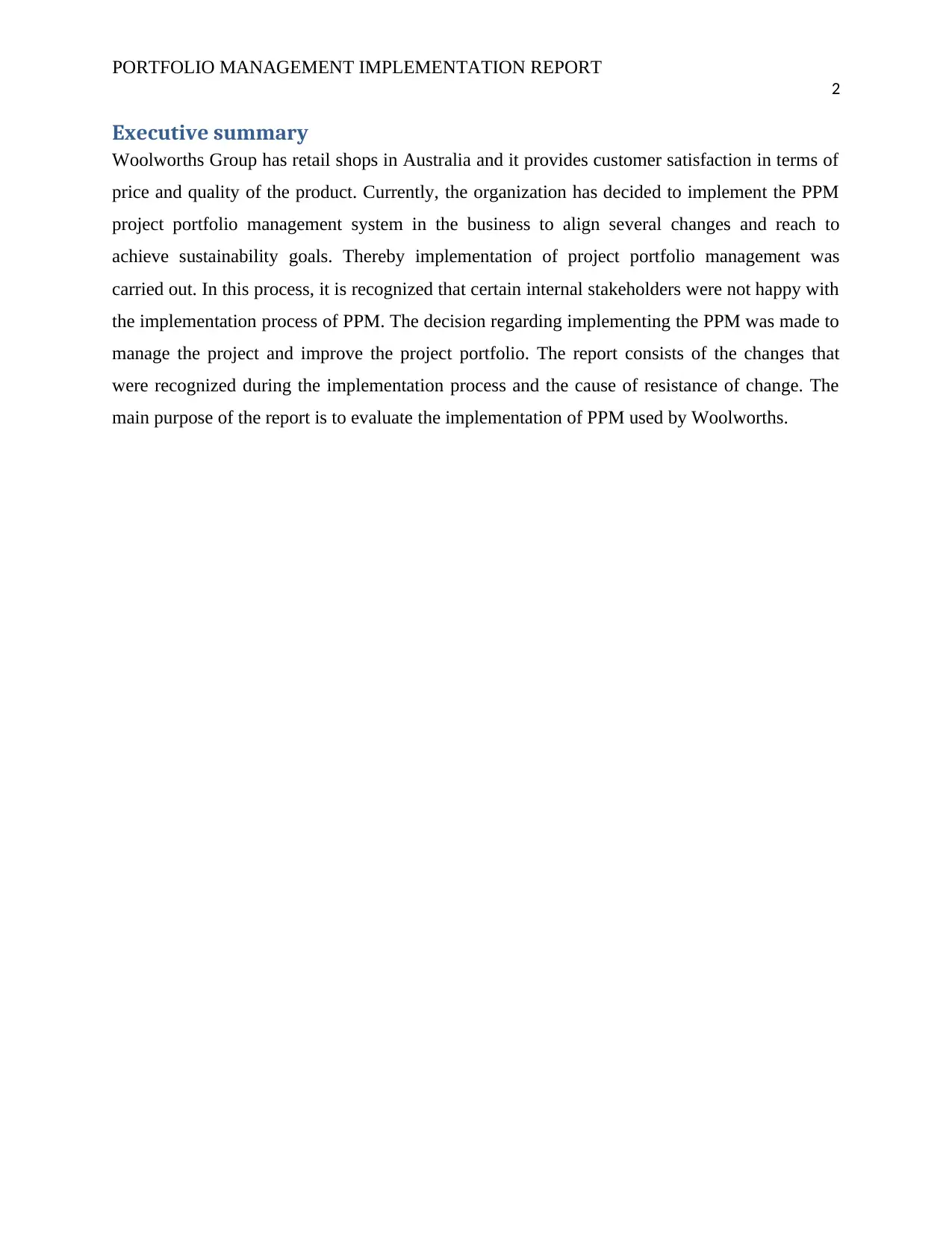
PORTFOLIO MANAGEMENT IMPLEMENTATION REPORT
2
Executive summary
Woolworths Group has retail shops in Australia and it provides customer satisfaction in terms of
price and quality of the product. Currently, the organization has decided to implement the PPM
project portfolio management system in the business to align several changes and reach to
achieve sustainability goals. Thereby implementation of project portfolio management was
carried out. In this process, it is recognized that certain internal stakeholders were not happy with
the implementation process of PPM. The decision regarding implementing the PPM was made to
manage the project and improve the project portfolio. The report consists of the changes that
were recognized during the implementation process and the cause of resistance of change. The
main purpose of the report is to evaluate the implementation of PPM used by Woolworths.
2
Executive summary
Woolworths Group has retail shops in Australia and it provides customer satisfaction in terms of
price and quality of the product. Currently, the organization has decided to implement the PPM
project portfolio management system in the business to align several changes and reach to
achieve sustainability goals. Thereby implementation of project portfolio management was
carried out. In this process, it is recognized that certain internal stakeholders were not happy with
the implementation process of PPM. The decision regarding implementing the PPM was made to
manage the project and improve the project portfolio. The report consists of the changes that
were recognized during the implementation process and the cause of resistance of change. The
main purpose of the report is to evaluate the implementation of PPM used by Woolworths.
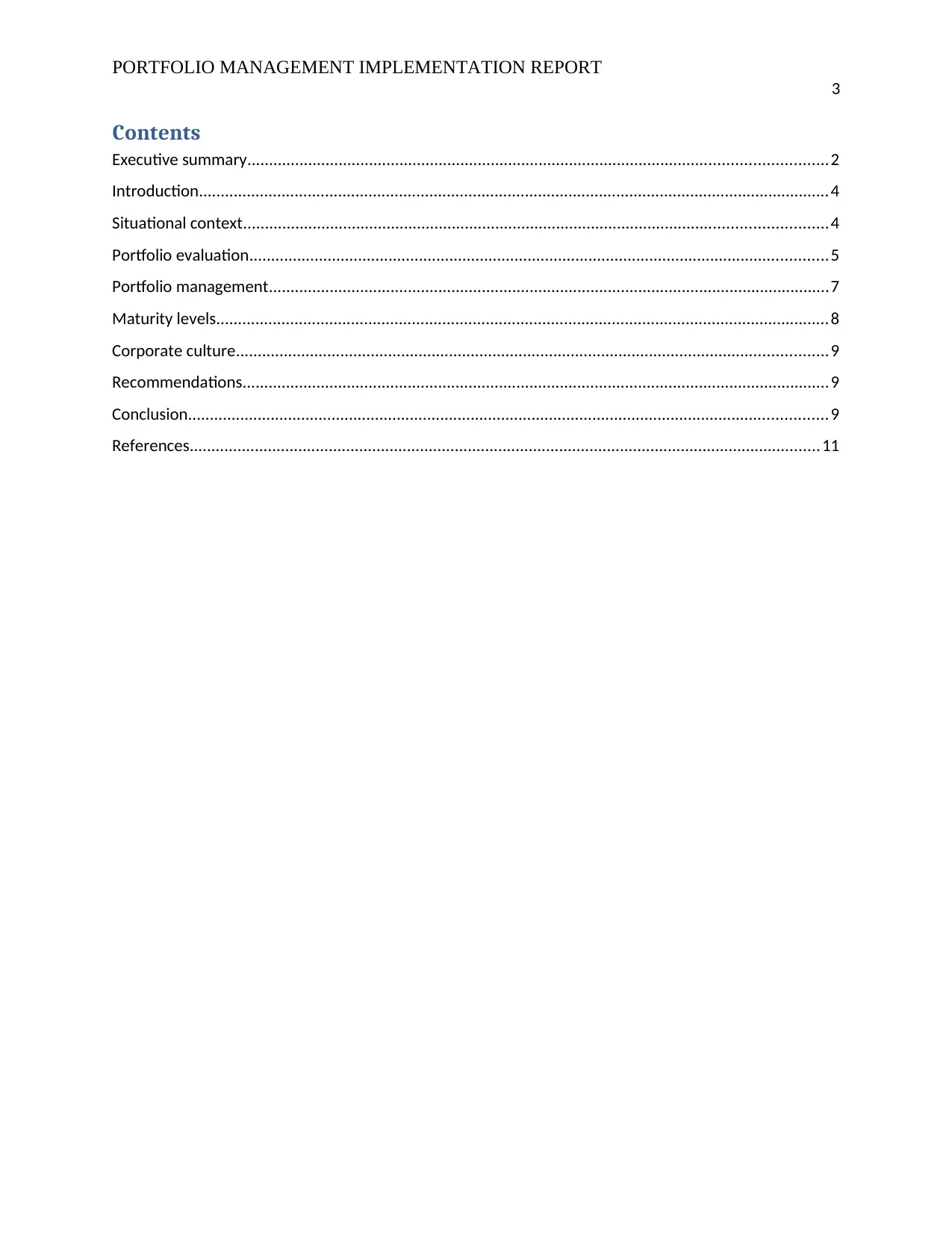
PORTFOLIO MANAGEMENT IMPLEMENTATION REPORT
3
Contents
Executive summary.....................................................................................................................................2
Introduction.................................................................................................................................................4
Situational context......................................................................................................................................4
Portfolio evaluation.....................................................................................................................................5
Portfolio management.................................................................................................................................7
Maturity levels.............................................................................................................................................8
Corporate culture........................................................................................................................................9
Recommendations.......................................................................................................................................9
Conclusion...................................................................................................................................................9
References.................................................................................................................................................11
3
Contents
Executive summary.....................................................................................................................................2
Introduction.................................................................................................................................................4
Situational context......................................................................................................................................4
Portfolio evaluation.....................................................................................................................................5
Portfolio management.................................................................................................................................7
Maturity levels.............................................................................................................................................8
Corporate culture........................................................................................................................................9
Recommendations.......................................................................................................................................9
Conclusion...................................................................................................................................................9
References.................................................................................................................................................11
⊘ This is a preview!⊘
Do you want full access?
Subscribe today to unlock all pages.

Trusted by 1+ million students worldwide
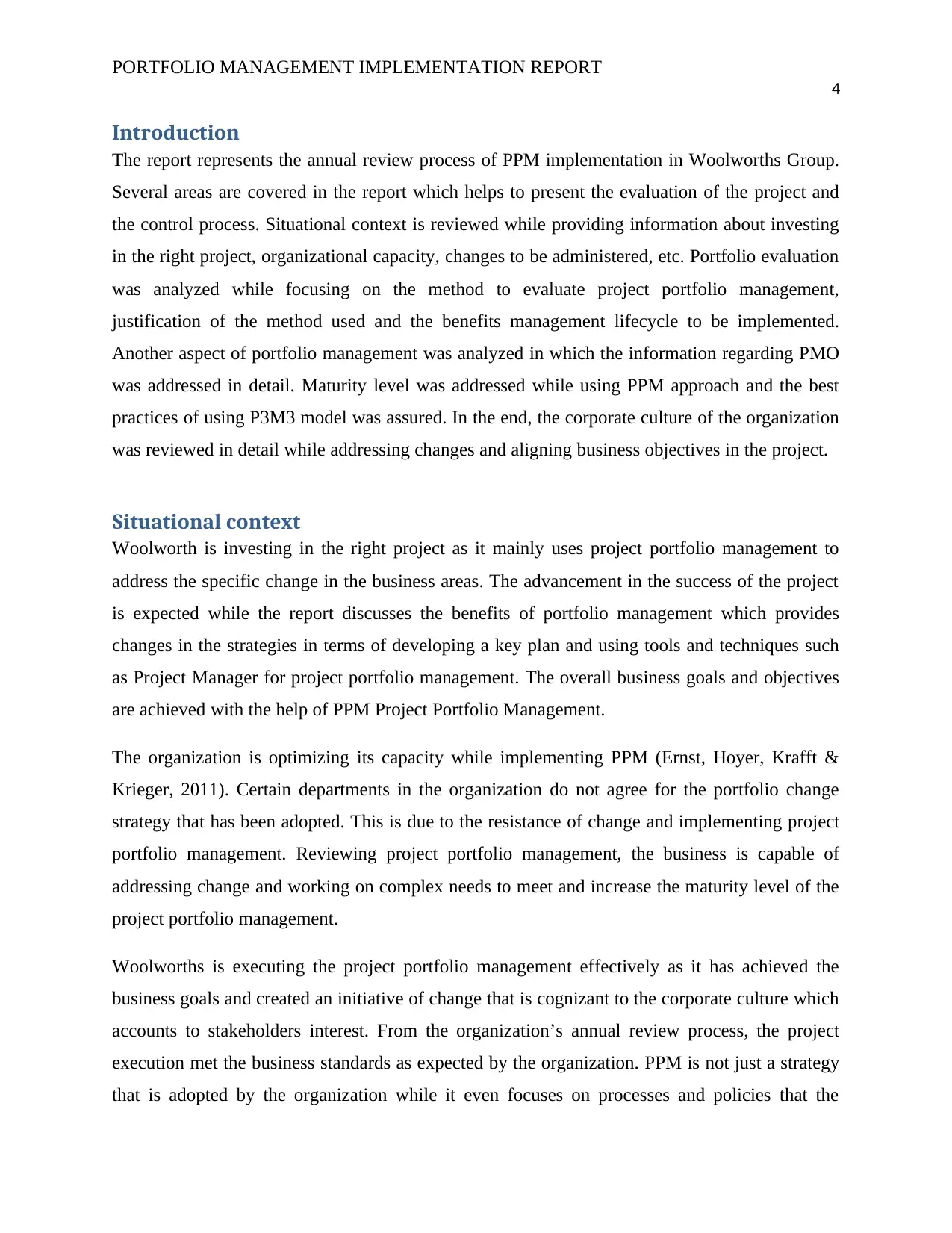
PORTFOLIO MANAGEMENT IMPLEMENTATION REPORT
4
Introduction
The report represents the annual review process of PPM implementation in Woolworths Group.
Several areas are covered in the report which helps to present the evaluation of the project and
the control process. Situational context is reviewed while providing information about investing
in the right project, organizational capacity, changes to be administered, etc. Portfolio evaluation
was analyzed while focusing on the method to evaluate project portfolio management,
justification of the method used and the benefits management lifecycle to be implemented.
Another aspect of portfolio management was analyzed in which the information regarding PMO
was addressed in detail. Maturity level was addressed while using PPM approach and the best
practices of using P3M3 model was assured. In the end, the corporate culture of the organization
was reviewed in detail while addressing changes and aligning business objectives in the project.
Situational context
Woolworth is investing in the right project as it mainly uses project portfolio management to
address the specific change in the business areas. The advancement in the success of the project
is expected while the report discusses the benefits of portfolio management which provides
changes in the strategies in terms of developing a key plan and using tools and techniques such
as Project Manager for project portfolio management. The overall business goals and objectives
are achieved with the help of PPM Project Portfolio Management.
The organization is optimizing its capacity while implementing PPM (Ernst, Hoyer, Krafft &
Krieger, 2011). Certain departments in the organization do not agree for the portfolio change
strategy that has been adopted. This is due to the resistance of change and implementing project
portfolio management. Reviewing project portfolio management, the business is capable of
addressing change and working on complex needs to meet and increase the maturity level of the
project portfolio management.
Woolworths is executing the project portfolio management effectively as it has achieved the
business goals and created an initiative of change that is cognizant to the corporate culture which
accounts to stakeholders interest. From the organization’s annual review process, the project
execution met the business standards as expected by the organization. PPM is not just a strategy
that is adopted by the organization while it even focuses on processes and policies that the
4
Introduction
The report represents the annual review process of PPM implementation in Woolworths Group.
Several areas are covered in the report which helps to present the evaluation of the project and
the control process. Situational context is reviewed while providing information about investing
in the right project, organizational capacity, changes to be administered, etc. Portfolio evaluation
was analyzed while focusing on the method to evaluate project portfolio management,
justification of the method used and the benefits management lifecycle to be implemented.
Another aspect of portfolio management was analyzed in which the information regarding PMO
was addressed in detail. Maturity level was addressed while using PPM approach and the best
practices of using P3M3 model was assured. In the end, the corporate culture of the organization
was reviewed in detail while addressing changes and aligning business objectives in the project.
Situational context
Woolworth is investing in the right project as it mainly uses project portfolio management to
address the specific change in the business areas. The advancement in the success of the project
is expected while the report discusses the benefits of portfolio management which provides
changes in the strategies in terms of developing a key plan and using tools and techniques such
as Project Manager for project portfolio management. The overall business goals and objectives
are achieved with the help of PPM Project Portfolio Management.
The organization is optimizing its capacity while implementing PPM (Ernst, Hoyer, Krafft &
Krieger, 2011). Certain departments in the organization do not agree for the portfolio change
strategy that has been adopted. This is due to the resistance of change and implementing project
portfolio management. Reviewing project portfolio management, the business is capable of
addressing change and working on complex needs to meet and increase the maturity level of the
project portfolio management.
Woolworths is executing the project portfolio management effectively as it has achieved the
business goals and created an initiative of change that is cognizant to the corporate culture which
accounts to stakeholders interest. From the organization’s annual review process, the project
execution met the business standards as expected by the organization. PPM is not just a strategy
that is adopted by the organization while it even focuses on processes and policies that the
Paraphrase This Document
Need a fresh take? Get an instant paraphrase of this document with our AI Paraphraser
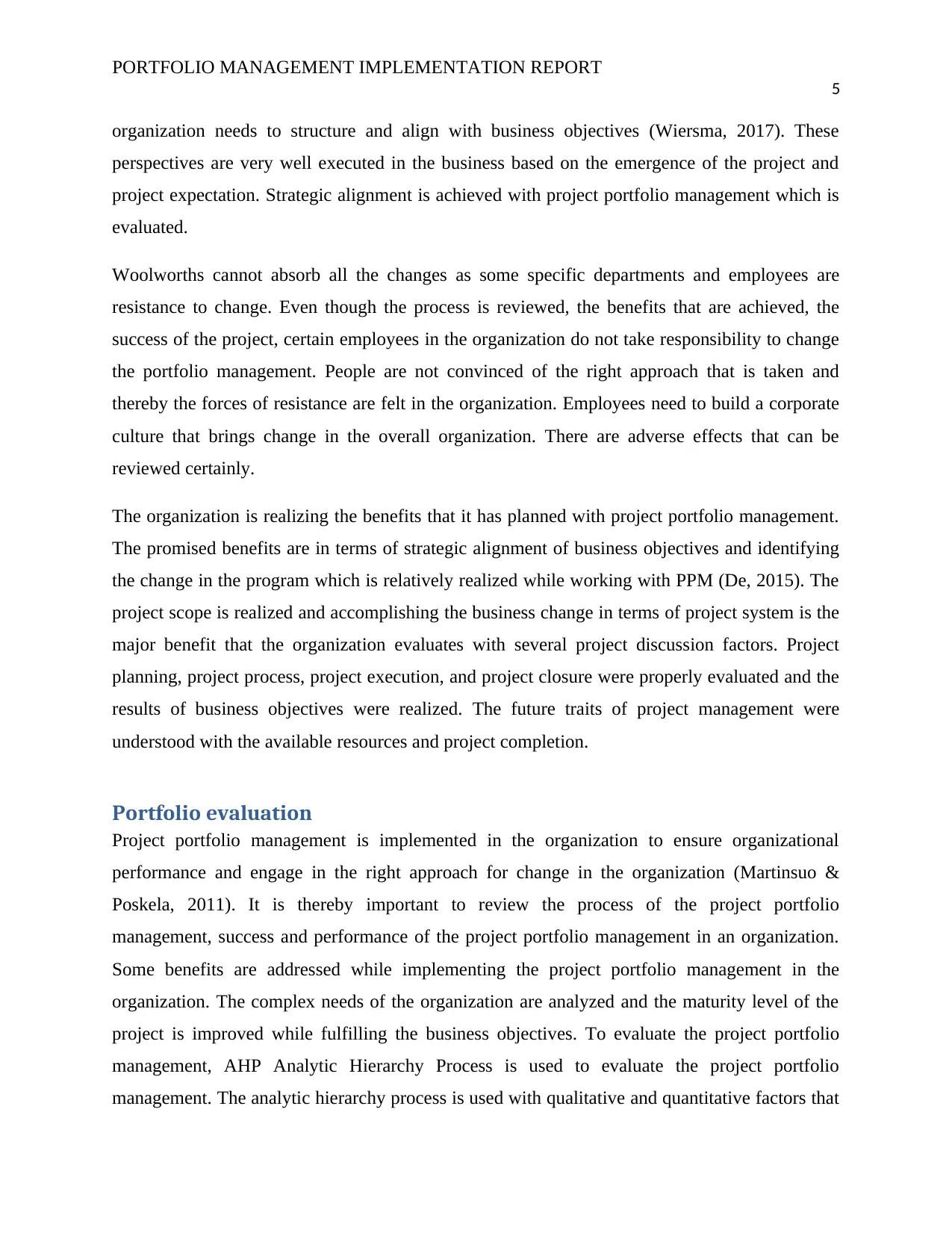
PORTFOLIO MANAGEMENT IMPLEMENTATION REPORT
5
organization needs to structure and align with business objectives (Wiersma, 2017). These
perspectives are very well executed in the business based on the emergence of the project and
project expectation. Strategic alignment is achieved with project portfolio management which is
evaluated.
Woolworths cannot absorb all the changes as some specific departments and employees are
resistance to change. Even though the process is reviewed, the benefits that are achieved, the
success of the project, certain employees in the organization do not take responsibility to change
the portfolio management. People are not convinced of the right approach that is taken and
thereby the forces of resistance are felt in the organization. Employees need to build a corporate
culture that brings change in the overall organization. There are adverse effects that can be
reviewed certainly.
The organization is realizing the benefits that it has planned with project portfolio management.
The promised benefits are in terms of strategic alignment of business objectives and identifying
the change in the program which is relatively realized while working with PPM (De, 2015). The
project scope is realized and accomplishing the business change in terms of project system is the
major benefit that the organization evaluates with several project discussion factors. Project
planning, project process, project execution, and project closure were properly evaluated and the
results of business objectives were realized. The future traits of project management were
understood with the available resources and project completion.
Portfolio evaluation
Project portfolio management is implemented in the organization to ensure organizational
performance and engage in the right approach for change in the organization (Martinsuo &
Poskela, 2011). It is thereby important to review the process of the project portfolio
management, success and performance of the project portfolio management in an organization.
Some benefits are addressed while implementing the project portfolio management in the
organization. The complex needs of the organization are analyzed and the maturity level of the
project is improved while fulfilling the business objectives. To evaluate the project portfolio
management, AHP Analytic Hierarchy Process is used to evaluate the project portfolio
management. The analytic hierarchy process is used with qualitative and quantitative factors that
5
organization needs to structure and align with business objectives (Wiersma, 2017). These
perspectives are very well executed in the business based on the emergence of the project and
project expectation. Strategic alignment is achieved with project portfolio management which is
evaluated.
Woolworths cannot absorb all the changes as some specific departments and employees are
resistance to change. Even though the process is reviewed, the benefits that are achieved, the
success of the project, certain employees in the organization do not take responsibility to change
the portfolio management. People are not convinced of the right approach that is taken and
thereby the forces of resistance are felt in the organization. Employees need to build a corporate
culture that brings change in the overall organization. There are adverse effects that can be
reviewed certainly.
The organization is realizing the benefits that it has planned with project portfolio management.
The promised benefits are in terms of strategic alignment of business objectives and identifying
the change in the program which is relatively realized while working with PPM (De, 2015). The
project scope is realized and accomplishing the business change in terms of project system is the
major benefit that the organization evaluates with several project discussion factors. Project
planning, project process, project execution, and project closure were properly evaluated and the
results of business objectives were realized. The future traits of project management were
understood with the available resources and project completion.
Portfolio evaluation
Project portfolio management is implemented in the organization to ensure organizational
performance and engage in the right approach for change in the organization (Martinsuo &
Poskela, 2011). It is thereby important to review the process of the project portfolio
management, success and performance of the project portfolio management in an organization.
Some benefits are addressed while implementing the project portfolio management in the
organization. The complex needs of the organization are analyzed and the maturity level of the
project is improved while fulfilling the business objectives. To evaluate the project portfolio
management, AHP Analytic Hierarchy Process is used to evaluate the project portfolio
management. The analytic hierarchy process is used with qualitative and quantitative factors that
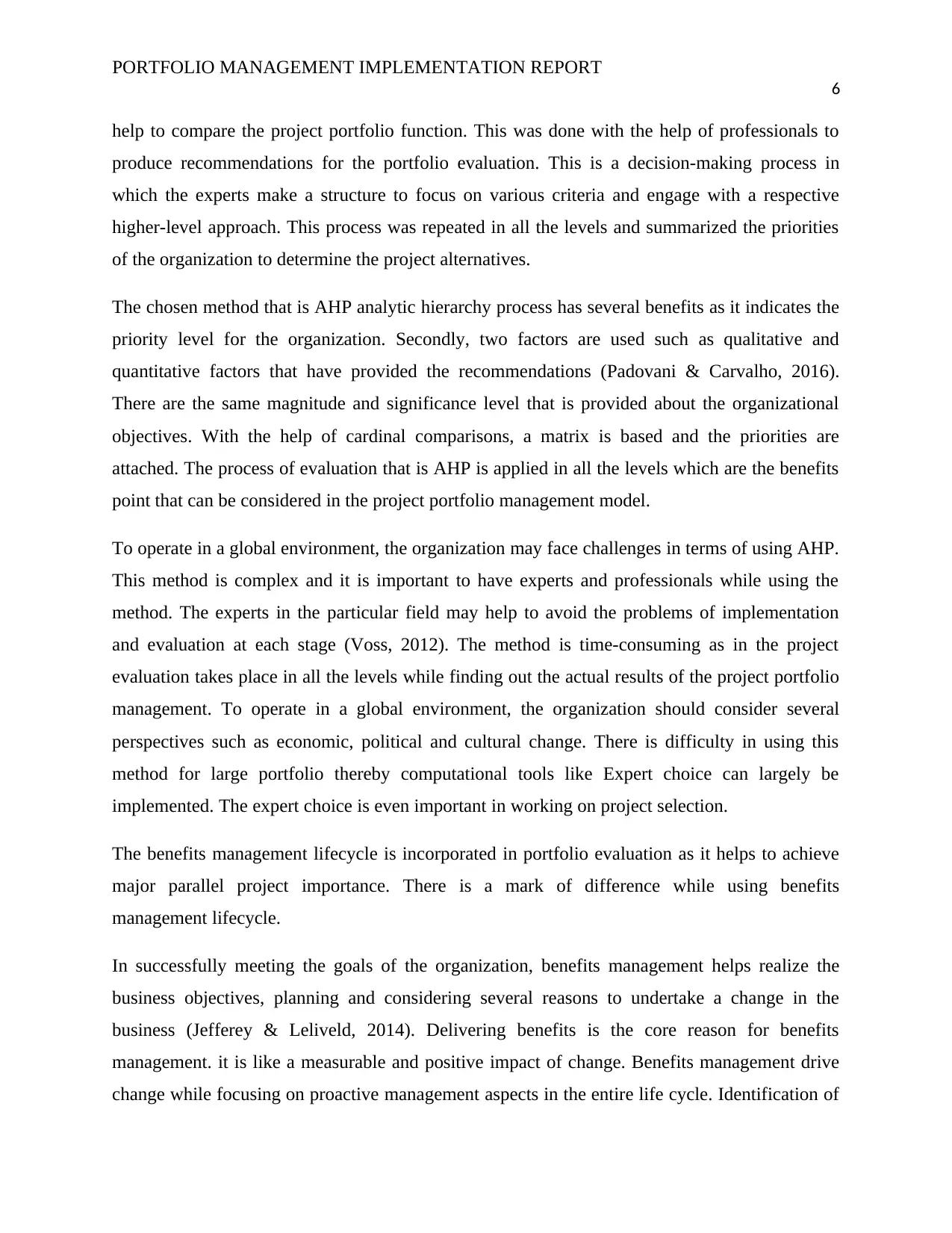
PORTFOLIO MANAGEMENT IMPLEMENTATION REPORT
6
help to compare the project portfolio function. This was done with the help of professionals to
produce recommendations for the portfolio evaluation. This is a decision-making process in
which the experts make a structure to focus on various criteria and engage with a respective
higher-level approach. This process was repeated in all the levels and summarized the priorities
of the organization to determine the project alternatives.
The chosen method that is AHP analytic hierarchy process has several benefits as it indicates the
priority level for the organization. Secondly, two factors are used such as qualitative and
quantitative factors that have provided the recommendations (Padovani & Carvalho, 2016).
There are the same magnitude and significance level that is provided about the organizational
objectives. With the help of cardinal comparisons, a matrix is based and the priorities are
attached. The process of evaluation that is AHP is applied in all the levels which are the benefits
point that can be considered in the project portfolio management model.
To operate in a global environment, the organization may face challenges in terms of using AHP.
This method is complex and it is important to have experts and professionals while using the
method. The experts in the particular field may help to avoid the problems of implementation
and evaluation at each stage (Voss, 2012). The method is time-consuming as in the project
evaluation takes place in all the levels while finding out the actual results of the project portfolio
management. To operate in a global environment, the organization should consider several
perspectives such as economic, political and cultural change. There is difficulty in using this
method for large portfolio thereby computational tools like Expert choice can largely be
implemented. The expert choice is even important in working on project selection.
The benefits management lifecycle is incorporated in portfolio evaluation as it helps to achieve
major parallel project importance. There is a mark of difference while using benefits
management lifecycle.
In successfully meeting the goals of the organization, benefits management helps realize the
business objectives, planning and considering several reasons to undertake a change in the
business (Jefferey & Leliveld, 2014). Delivering benefits is the core reason for benefits
management. it is like a measurable and positive impact of change. Benefits management drive
change while focusing on proactive management aspects in the entire life cycle. Identification of
6
help to compare the project portfolio function. This was done with the help of professionals to
produce recommendations for the portfolio evaluation. This is a decision-making process in
which the experts make a structure to focus on various criteria and engage with a respective
higher-level approach. This process was repeated in all the levels and summarized the priorities
of the organization to determine the project alternatives.
The chosen method that is AHP analytic hierarchy process has several benefits as it indicates the
priority level for the organization. Secondly, two factors are used such as qualitative and
quantitative factors that have provided the recommendations (Padovani & Carvalho, 2016).
There are the same magnitude and significance level that is provided about the organizational
objectives. With the help of cardinal comparisons, a matrix is based and the priorities are
attached. The process of evaluation that is AHP is applied in all the levels which are the benefits
point that can be considered in the project portfolio management model.
To operate in a global environment, the organization may face challenges in terms of using AHP.
This method is complex and it is important to have experts and professionals while using the
method. The experts in the particular field may help to avoid the problems of implementation
and evaluation at each stage (Voss, 2012). The method is time-consuming as in the project
evaluation takes place in all the levels while finding out the actual results of the project portfolio
management. To operate in a global environment, the organization should consider several
perspectives such as economic, political and cultural change. There is difficulty in using this
method for large portfolio thereby computational tools like Expert choice can largely be
implemented. The expert choice is even important in working on project selection.
The benefits management lifecycle is incorporated in portfolio evaluation as it helps to achieve
major parallel project importance. There is a mark of difference while using benefits
management lifecycle.
In successfully meeting the goals of the organization, benefits management helps realize the
business objectives, planning and considering several reasons to undertake a change in the
business (Jefferey & Leliveld, 2014). Delivering benefits is the core reason for benefits
management. it is like a measurable and positive impact of change. Benefits management drive
change while focusing on proactive management aspects in the entire life cycle. Identification of
⊘ This is a preview!⊘
Do you want full access?
Subscribe today to unlock all pages.

Trusted by 1+ million students worldwide
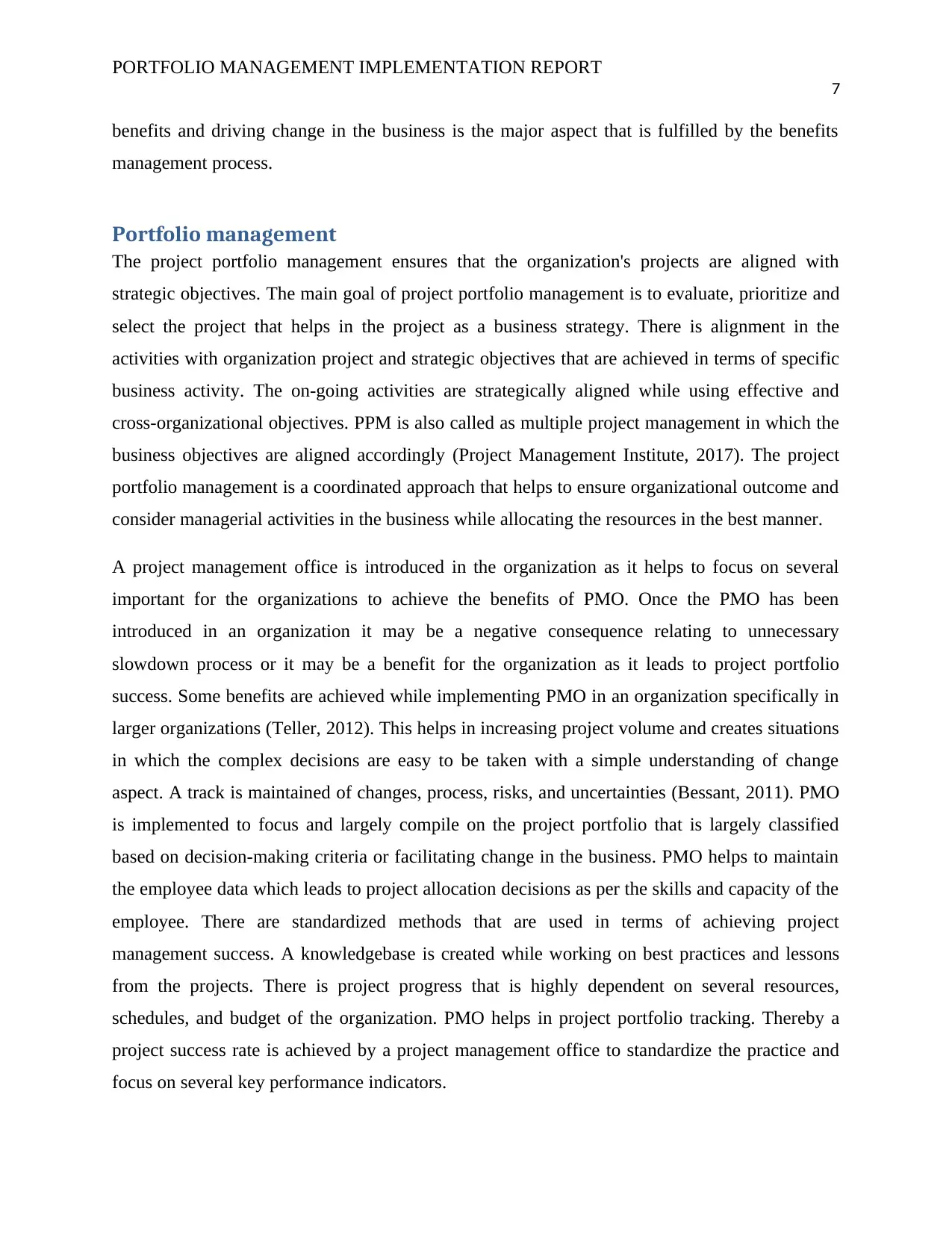
PORTFOLIO MANAGEMENT IMPLEMENTATION REPORT
7
benefits and driving change in the business is the major aspect that is fulfilled by the benefits
management process.
Portfolio management
The project portfolio management ensures that the organization's projects are aligned with
strategic objectives. The main goal of project portfolio management is to evaluate, prioritize and
select the project that helps in the project as a business strategy. There is alignment in the
activities with organization project and strategic objectives that are achieved in terms of specific
business activity. The on-going activities are strategically aligned while using effective and
cross-organizational objectives. PPM is also called as multiple project management in which the
business objectives are aligned accordingly (Project Management Institute, 2017). The project
portfolio management is a coordinated approach that helps to ensure organizational outcome and
consider managerial activities in the business while allocating the resources in the best manner.
A project management office is introduced in the organization as it helps to focus on several
important for the organizations to achieve the benefits of PMO. Once the PMO has been
introduced in an organization it may be a negative consequence relating to unnecessary
slowdown process or it may be a benefit for the organization as it leads to project portfolio
success. Some benefits are achieved while implementing PMO in an organization specifically in
larger organizations (Teller, 2012). This helps in increasing project volume and creates situations
in which the complex decisions are easy to be taken with a simple understanding of change
aspect. A track is maintained of changes, process, risks, and uncertainties (Bessant, 2011). PMO
is implemented to focus and largely compile on the project portfolio that is largely classified
based on decision-making criteria or facilitating change in the business. PMO helps to maintain
the employee data which leads to project allocation decisions as per the skills and capacity of the
employee. There are standardized methods that are used in terms of achieving project
management success. A knowledgebase is created while working on best practices and lessons
from the projects. There is project progress that is highly dependent on several resources,
schedules, and budget of the organization. PMO helps in project portfolio tracking. Thereby a
project success rate is achieved by a project management office to standardize the practice and
focus on several key performance indicators.
7
benefits and driving change in the business is the major aspect that is fulfilled by the benefits
management process.
Portfolio management
The project portfolio management ensures that the organization's projects are aligned with
strategic objectives. The main goal of project portfolio management is to evaluate, prioritize and
select the project that helps in the project as a business strategy. There is alignment in the
activities with organization project and strategic objectives that are achieved in terms of specific
business activity. The on-going activities are strategically aligned while using effective and
cross-organizational objectives. PPM is also called as multiple project management in which the
business objectives are aligned accordingly (Project Management Institute, 2017). The project
portfolio management is a coordinated approach that helps to ensure organizational outcome and
consider managerial activities in the business while allocating the resources in the best manner.
A project management office is introduced in the organization as it helps to focus on several
important for the organizations to achieve the benefits of PMO. Once the PMO has been
introduced in an organization it may be a negative consequence relating to unnecessary
slowdown process or it may be a benefit for the organization as it leads to project portfolio
success. Some benefits are achieved while implementing PMO in an organization specifically in
larger organizations (Teller, 2012). This helps in increasing project volume and creates situations
in which the complex decisions are easy to be taken with a simple understanding of change
aspect. A track is maintained of changes, process, risks, and uncertainties (Bessant, 2011). PMO
is implemented to focus and largely compile on the project portfolio that is largely classified
based on decision-making criteria or facilitating change in the business. PMO helps to maintain
the employee data which leads to project allocation decisions as per the skills and capacity of the
employee. There are standardized methods that are used in terms of achieving project
management success. A knowledgebase is created while working on best practices and lessons
from the projects. There is project progress that is highly dependent on several resources,
schedules, and budget of the organization. PMO helps in project portfolio tracking. Thereby a
project success rate is achieved by a project management office to standardize the practice and
focus on several key performance indicators.
Paraphrase This Document
Need a fresh take? Get an instant paraphrase of this document with our AI Paraphraser
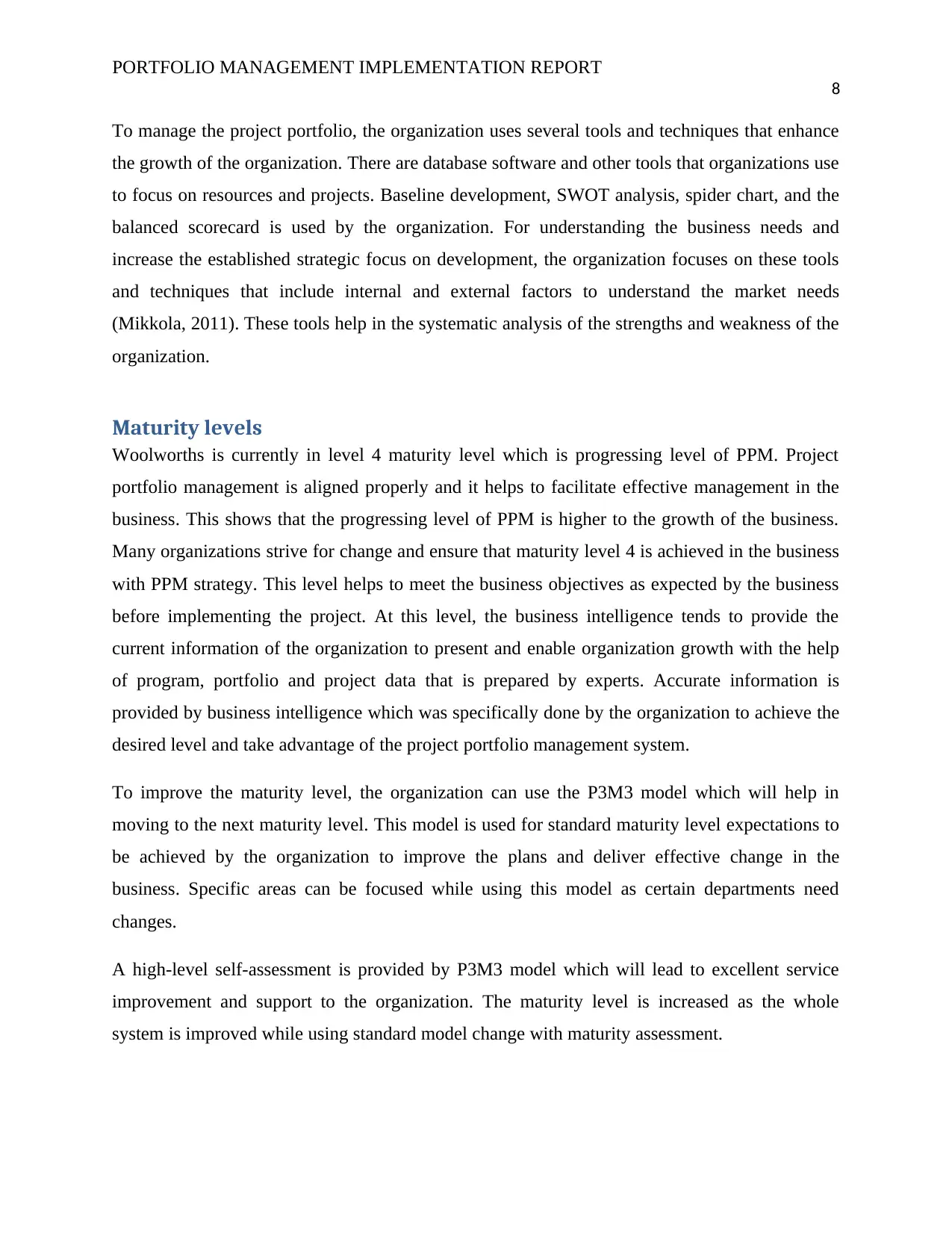
PORTFOLIO MANAGEMENT IMPLEMENTATION REPORT
8
To manage the project portfolio, the organization uses several tools and techniques that enhance
the growth of the organization. There are database software and other tools that organizations use
to focus on resources and projects. Baseline development, SWOT analysis, spider chart, and the
balanced scorecard is used by the organization. For understanding the business needs and
increase the established strategic focus on development, the organization focuses on these tools
and techniques that include internal and external factors to understand the market needs
(Mikkola, 2011). These tools help in the systematic analysis of the strengths and weakness of the
organization.
Maturity levels
Woolworths is currently in level 4 maturity level which is progressing level of PPM. Project
portfolio management is aligned properly and it helps to facilitate effective management in the
business. This shows that the progressing level of PPM is higher to the growth of the business.
Many organizations strive for change and ensure that maturity level 4 is achieved in the business
with PPM strategy. This level helps to meet the business objectives as expected by the business
before implementing the project. At this level, the business intelligence tends to provide the
current information of the organization to present and enable organization growth with the help
of program, portfolio and project data that is prepared by experts. Accurate information is
provided by business intelligence which was specifically done by the organization to achieve the
desired level and take advantage of the project portfolio management system.
To improve the maturity level, the organization can use the P3M3 model which will help in
moving to the next maturity level. This model is used for standard maturity level expectations to
be achieved by the organization to improve the plans and deliver effective change in the
business. Specific areas can be focused while using this model as certain departments need
changes.
A high-level self-assessment is provided by P3M3 model which will lead to excellent service
improvement and support to the organization. The maturity level is increased as the whole
system is improved while using standard model change with maturity assessment.
8
To manage the project portfolio, the organization uses several tools and techniques that enhance
the growth of the organization. There are database software and other tools that organizations use
to focus on resources and projects. Baseline development, SWOT analysis, spider chart, and the
balanced scorecard is used by the organization. For understanding the business needs and
increase the established strategic focus on development, the organization focuses on these tools
and techniques that include internal and external factors to understand the market needs
(Mikkola, 2011). These tools help in the systematic analysis of the strengths and weakness of the
organization.
Maturity levels
Woolworths is currently in level 4 maturity level which is progressing level of PPM. Project
portfolio management is aligned properly and it helps to facilitate effective management in the
business. This shows that the progressing level of PPM is higher to the growth of the business.
Many organizations strive for change and ensure that maturity level 4 is achieved in the business
with PPM strategy. This level helps to meet the business objectives as expected by the business
before implementing the project. At this level, the business intelligence tends to provide the
current information of the organization to present and enable organization growth with the help
of program, portfolio and project data that is prepared by experts. Accurate information is
provided by business intelligence which was specifically done by the organization to achieve the
desired level and take advantage of the project portfolio management system.
To improve the maturity level, the organization can use the P3M3 model which will help in
moving to the next maturity level. This model is used for standard maturity level expectations to
be achieved by the organization to improve the plans and deliver effective change in the
business. Specific areas can be focused while using this model as certain departments need
changes.
A high-level self-assessment is provided by P3M3 model which will lead to excellent service
improvement and support to the organization. The maturity level is increased as the whole
system is improved while using standard model change with maturity assessment.
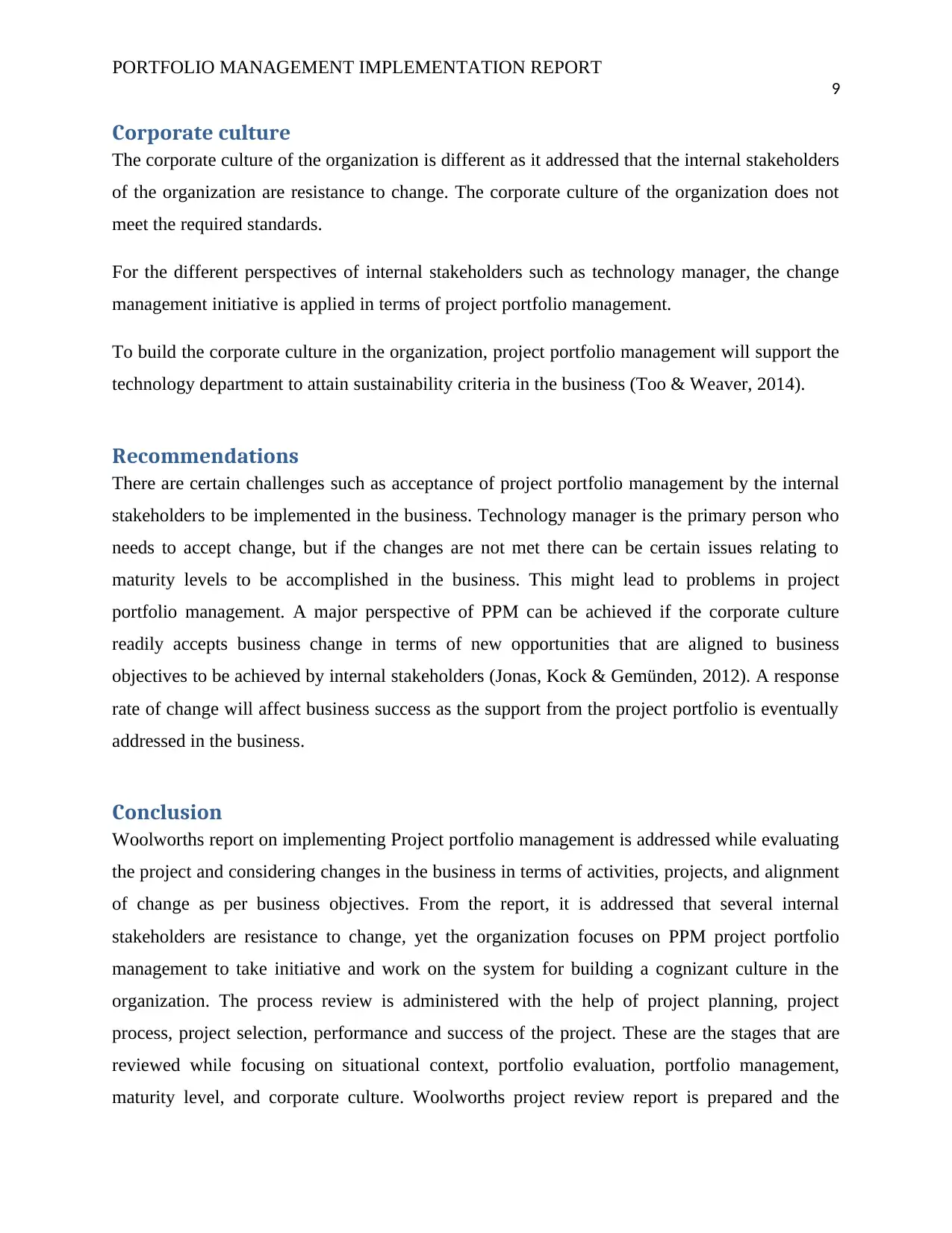
PORTFOLIO MANAGEMENT IMPLEMENTATION REPORT
9
Corporate culture
The corporate culture of the organization is different as it addressed that the internal stakeholders
of the organization are resistance to change. The corporate culture of the organization does not
meet the required standards.
For the different perspectives of internal stakeholders such as technology manager, the change
management initiative is applied in terms of project portfolio management.
To build the corporate culture in the organization, project portfolio management will support the
technology department to attain sustainability criteria in the business (Too & Weaver, 2014).
Recommendations
There are certain challenges such as acceptance of project portfolio management by the internal
stakeholders to be implemented in the business. Technology manager is the primary person who
needs to accept change, but if the changes are not met there can be certain issues relating to
maturity levels to be accomplished in the business. This might lead to problems in project
portfolio management. A major perspective of PPM can be achieved if the corporate culture
readily accepts business change in terms of new opportunities that are aligned to business
objectives to be achieved by internal stakeholders (Jonas, Kock & Gemünden, 2012). A response
rate of change will affect business success as the support from the project portfolio is eventually
addressed in the business.
Conclusion
Woolworths report on implementing Project portfolio management is addressed while evaluating
the project and considering changes in the business in terms of activities, projects, and alignment
of change as per business objectives. From the report, it is addressed that several internal
stakeholders are resistance to change, yet the organization focuses on PPM project portfolio
management to take initiative and work on the system for building a cognizant culture in the
organization. The process review is administered with the help of project planning, project
process, project selection, performance and success of the project. These are the stages that are
reviewed while focusing on situational context, portfolio evaluation, portfolio management,
maturity level, and corporate culture. Woolworths project review report is prepared and the
9
Corporate culture
The corporate culture of the organization is different as it addressed that the internal stakeholders
of the organization are resistance to change. The corporate culture of the organization does not
meet the required standards.
For the different perspectives of internal stakeholders such as technology manager, the change
management initiative is applied in terms of project portfolio management.
To build the corporate culture in the organization, project portfolio management will support the
technology department to attain sustainability criteria in the business (Too & Weaver, 2014).
Recommendations
There are certain challenges such as acceptance of project portfolio management by the internal
stakeholders to be implemented in the business. Technology manager is the primary person who
needs to accept change, but if the changes are not met there can be certain issues relating to
maturity levels to be accomplished in the business. This might lead to problems in project
portfolio management. A major perspective of PPM can be achieved if the corporate culture
readily accepts business change in terms of new opportunities that are aligned to business
objectives to be achieved by internal stakeholders (Jonas, Kock & Gemünden, 2012). A response
rate of change will affect business success as the support from the project portfolio is eventually
addressed in the business.
Conclusion
Woolworths report on implementing Project portfolio management is addressed while evaluating
the project and considering changes in the business in terms of activities, projects, and alignment
of change as per business objectives. From the report, it is addressed that several internal
stakeholders are resistance to change, yet the organization focuses on PPM project portfolio
management to take initiative and work on the system for building a cognizant culture in the
organization. The process review is administered with the help of project planning, project
process, project selection, performance and success of the project. These are the stages that are
reviewed while focusing on situational context, portfolio evaluation, portfolio management,
maturity level, and corporate culture. Woolworths project review report is prepared and the
⊘ This is a preview!⊘
Do you want full access?
Subscribe today to unlock all pages.

Trusted by 1+ million students worldwide
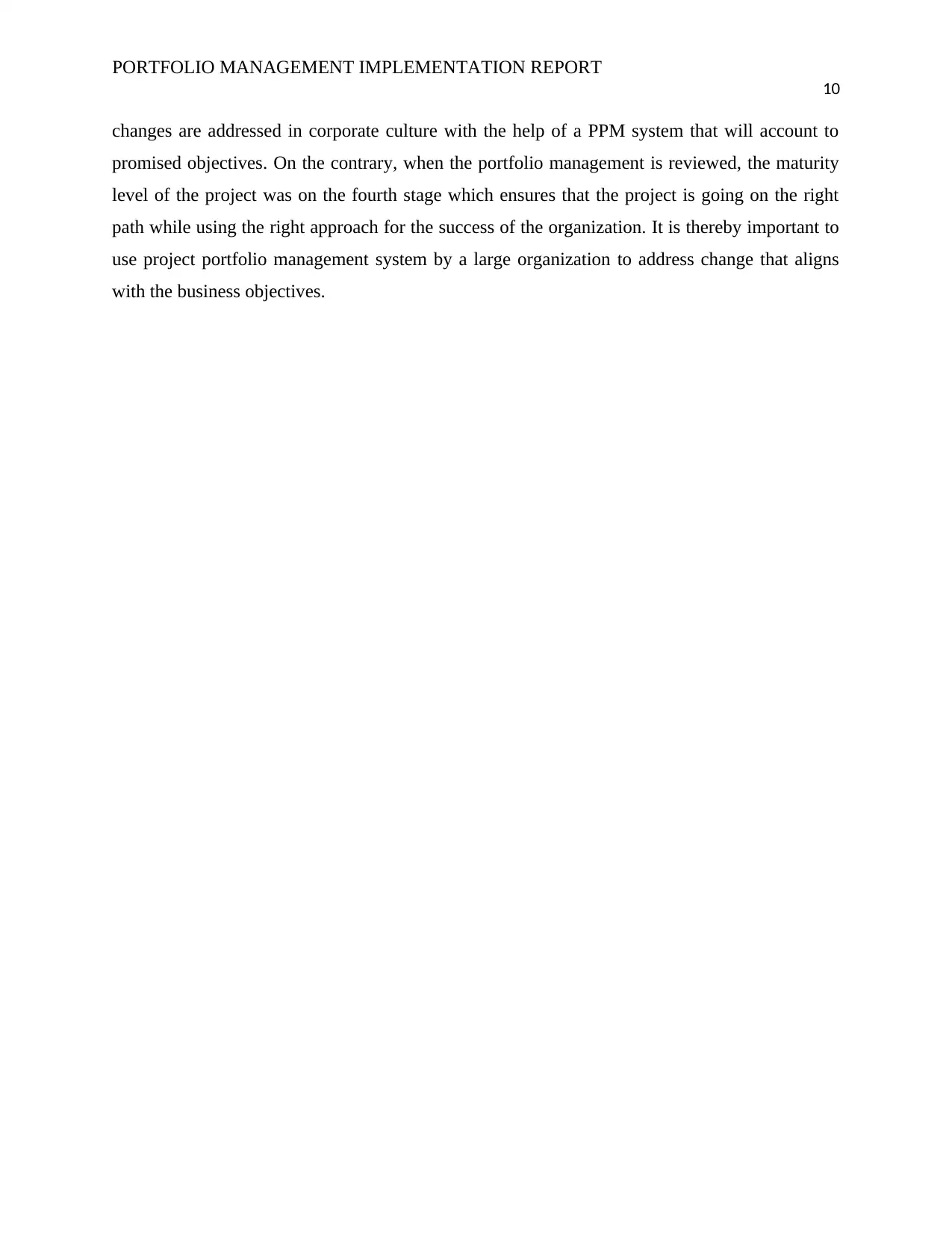
PORTFOLIO MANAGEMENT IMPLEMENTATION REPORT
10
changes are addressed in corporate culture with the help of a PPM system that will account to
promised objectives. On the contrary, when the portfolio management is reviewed, the maturity
level of the project was on the fourth stage which ensures that the project is going on the right
path while using the right approach for the success of the organization. It is thereby important to
use project portfolio management system by a large organization to address change that aligns
with the business objectives.
10
changes are addressed in corporate culture with the help of a PPM system that will account to
promised objectives. On the contrary, when the portfolio management is reviewed, the maturity
level of the project was on the fourth stage which ensures that the project is going on the right
path while using the right approach for the success of the organization. It is thereby important to
use project portfolio management system by a large organization to address change that aligns
with the business objectives.
Paraphrase This Document
Need a fresh take? Get an instant paraphrase of this document with our AI Paraphraser
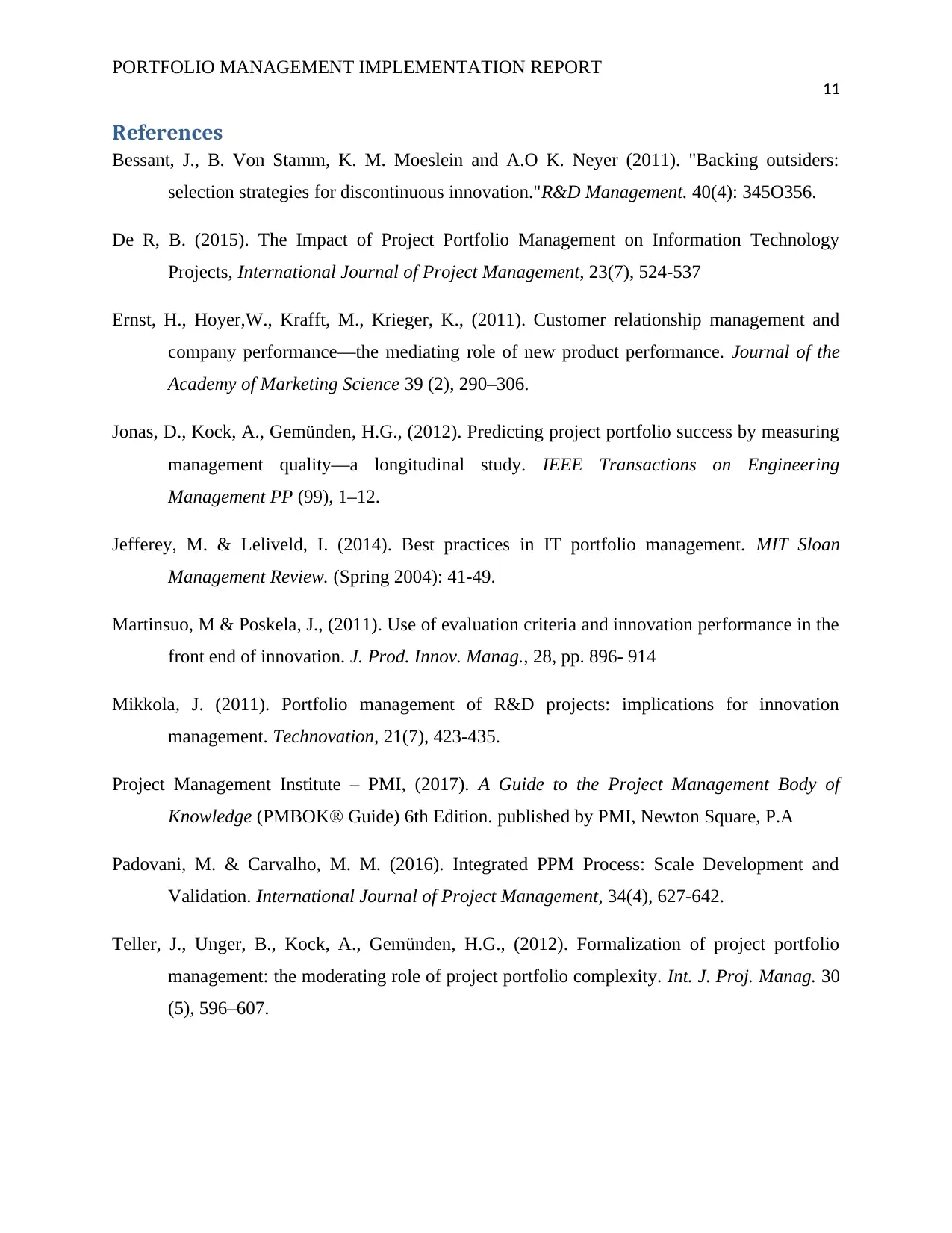
PORTFOLIO MANAGEMENT IMPLEMENTATION REPORT
11
References
Bessant, J., B. Von Stamm, K. M. Moeslein and A.O K. Neyer (2011). "Backing outsiders:
selection strategies for discontinuous innovation."R&D Management. 40(4): 345O356.
De R, B. (2015). The Impact of Project Portfolio Management on Information Technology
Projects, International Journal of Project Management, 23(7), 524-537
Ernst, H., Hoyer,W., Krafft, M., Krieger, K., (2011). Customer relationship management and
company performance—the mediating role of new product performance. Journal of the
Academy of Marketing Science 39 (2), 290–306.
Jonas, D., Kock, A., Gemünden, H.G., (2012). Predicting project portfolio success by measuring
management quality—a longitudinal study. IEEE Transactions on Engineering
Management PP (99), 1–12.
Jefferey, M. & Leliveld, I. (2014). Best practices in IT portfolio management. MIT Sloan
Management Review. (Spring 2004): 41-49.
Martinsuo, M & Poskela, J., (2011). Use of evaluation criteria and innovation performance in the
front end of innovation. J. Prod. Innov. Manag., 28, pp. 896- 914
Mikkola, J. (2011). Portfolio management of R&D projects: implications for innovation
management. Technovation, 21(7), 423-435.
Project Management Institute – PMI, (2017). A Guide to the Project Management Body of
Knowledge (PMBOK® Guide) 6th Edition. published by PMI, Newton Square, P.A
Padovani, M. & Carvalho, M. M. (2016). Integrated PPM Process: Scale Development and
Validation. International Journal of Project Management, 34(4), 627-642.
Teller, J., Unger, B., Kock, A., Gemünden, H.G., (2012). Formalization of project portfolio
management: the moderating role of project portfolio complexity. Int. J. Proj. Manag. 30
(5), 596–607.
11
References
Bessant, J., B. Von Stamm, K. M. Moeslein and A.O K. Neyer (2011). "Backing outsiders:
selection strategies for discontinuous innovation."R&D Management. 40(4): 345O356.
De R, B. (2015). The Impact of Project Portfolio Management on Information Technology
Projects, International Journal of Project Management, 23(7), 524-537
Ernst, H., Hoyer,W., Krafft, M., Krieger, K., (2011). Customer relationship management and
company performance—the mediating role of new product performance. Journal of the
Academy of Marketing Science 39 (2), 290–306.
Jonas, D., Kock, A., Gemünden, H.G., (2012). Predicting project portfolio success by measuring
management quality—a longitudinal study. IEEE Transactions on Engineering
Management PP (99), 1–12.
Jefferey, M. & Leliveld, I. (2014). Best practices in IT portfolio management. MIT Sloan
Management Review. (Spring 2004): 41-49.
Martinsuo, M & Poskela, J., (2011). Use of evaluation criteria and innovation performance in the
front end of innovation. J. Prod. Innov. Manag., 28, pp. 896- 914
Mikkola, J. (2011). Portfolio management of R&D projects: implications for innovation
management. Technovation, 21(7), 423-435.
Project Management Institute – PMI, (2017). A Guide to the Project Management Body of
Knowledge (PMBOK® Guide) 6th Edition. published by PMI, Newton Square, P.A
Padovani, M. & Carvalho, M. M. (2016). Integrated PPM Process: Scale Development and
Validation. International Journal of Project Management, 34(4), 627-642.
Teller, J., Unger, B., Kock, A., Gemünden, H.G., (2012). Formalization of project portfolio
management: the moderating role of project portfolio complexity. Int. J. Proj. Manag. 30
(5), 596–607.
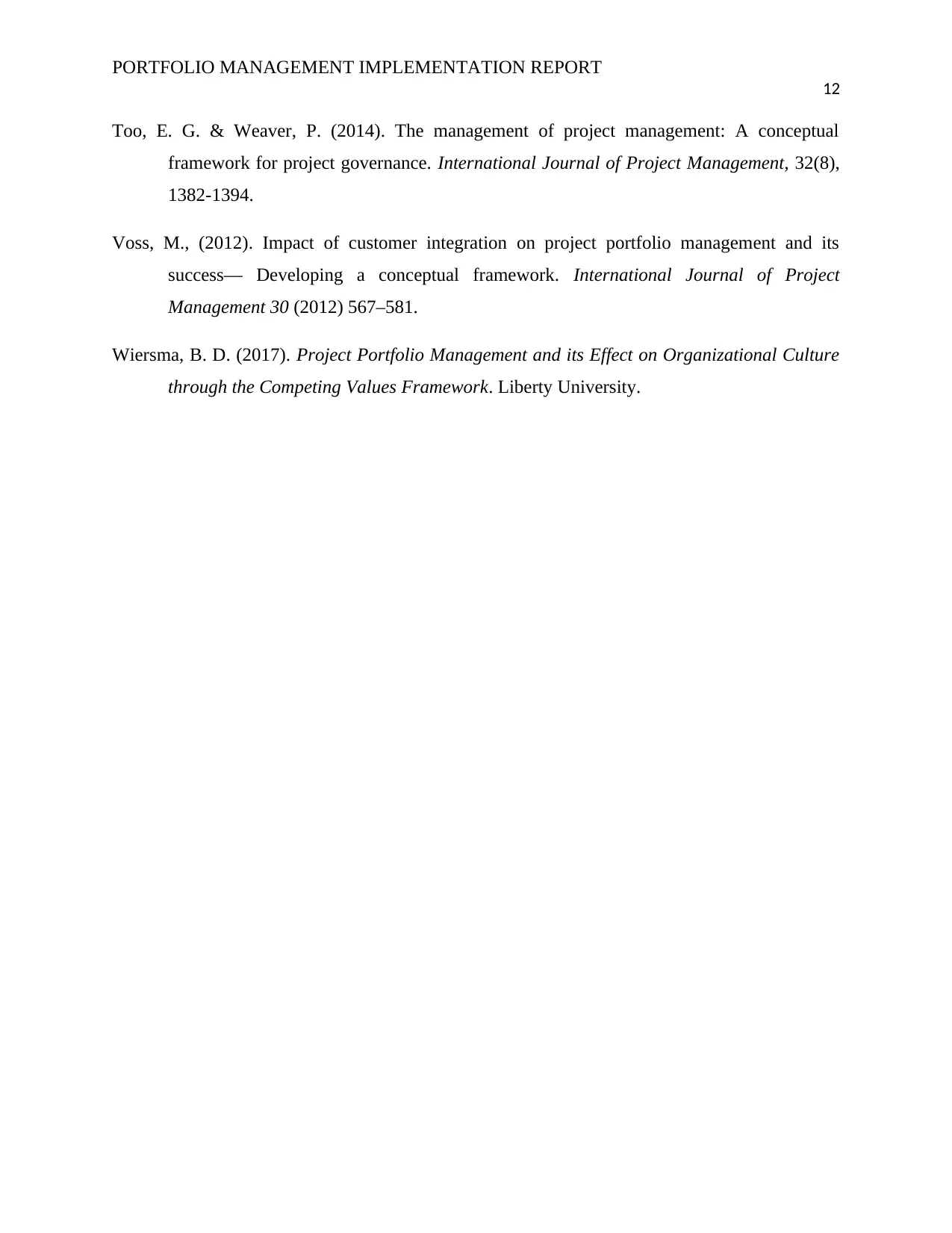
PORTFOLIO MANAGEMENT IMPLEMENTATION REPORT
12
Too, E. G. & Weaver, P. (2014). The management of project management: A conceptual
framework for project governance. International Journal of Project Management, 32(8),
1382-1394.
Voss, M., (2012). Impact of customer integration on project portfolio management and its
success— Developing a conceptual framework. International Journal of Project
Management 30 (2012) 567–581.
Wiersma, B. D. (2017). Project Portfolio Management and its Effect on Organizational Culture
through the Competing Values Framework. Liberty University.
12
Too, E. G. & Weaver, P. (2014). The management of project management: A conceptual
framework for project governance. International Journal of Project Management, 32(8),
1382-1394.
Voss, M., (2012). Impact of customer integration on project portfolio management and its
success— Developing a conceptual framework. International Journal of Project
Management 30 (2012) 567–581.
Wiersma, B. D. (2017). Project Portfolio Management and its Effect on Organizational Culture
through the Competing Values Framework. Liberty University.
⊘ This is a preview!⊘
Do you want full access?
Subscribe today to unlock all pages.

Trusted by 1+ million students worldwide
1 out of 12
Related Documents
Your All-in-One AI-Powered Toolkit for Academic Success.
+13062052269
info@desklib.com
Available 24*7 on WhatsApp / Email
![[object Object]](/_next/static/media/star-bottom.7253800d.svg)
Unlock your academic potential
Copyright © 2020–2025 A2Z Services. All Rights Reserved. Developed and managed by ZUCOL.





